11th Sep 2023
Sioux Drills a division of Snap On Tools | Why Sioux Pneumatic Drills are a Must Have for Production Hole Making

What makes a Pneumatic Drill a must have tool for industrial manufacturing?
A pneumatic drill sometimes referred to as a drill motor is a versatile tool that uses compressed air to power a rotary vane air motor, making it capable of drilling, reaming, tapping, and hole-sawing. Compressed air within the drill flows over the motor blades to generate rotational motion and supply the necessary energy for its operations. The drill employs a gear reduction mechanism to adjust the output, creating an appropriate RPM range and torque suitable for the specific task at hand.
In contrast, electric drills, while capable, often struggle with sustained high torque applications. They can be limited by their power source and may lack the consistent force needed for demanding tasks. Electric drills also have an on off duty cycle which means they require a rest. Sioux Drills excel in power, durability, and efficiency, showcasing their prowess across industries. When pitted against electric drills, they offer greater torque for challenging tasks and prolonged operational value, making them an outstanding choice for drilling excellence in the long term.
A pneumatic drill is made up of several components:

- The Body: Sioux drills are offered with various handle configurations such as Pistol Grip, Inline, D-Handle, and T-Handle. The handles have an ergonomic grip that enhances control and allows easy throttle manipulation for precise operation.
- Gearing: Th gear train determines a pneumatic drill's RPM range and torque output. Its adaptability and versatility ensure the drill's effectiveness across different applications, and it can be optimized for tasks requiring either high-speed rotation or higher torque.
- Motor: At the core of any pneumatic drill lies its motor, available in reversible and non-reversible configurations, each offering different RPM and torque settings. This means operators can choose the appropriate configuration needed to power and control various drilling operations.
- Throttle Valve: Operated through the trigger, this valve regulates the airflow into the motor by adjusting the flow of compressed air to control the drill's RPM. Users can set the desired speed and precise control over drilling operations based on the material and application requirements. Sioux drills feature precision valving which allows operators to"feather" the trigger.
- Trigger: Functioning akin to a guns trigger, the trigger of a pneumatic drill controls the tool's operation. When pressed, it releases compressed air into the motor, initiating the rotation of the attached drill bit within the chosen RPM range. This intuitive mechanism enables operators to easily start, stop, or control the drill's actions to enhance user experience and accuracy.
- Chuck: There are of two types – keyed and keyless. The keyed chucks need a wrench to tighten the jaws around the bit, while the keyless chucks enable tool-less bit changes for increased efficiency and convenience during drilling tasks. 80% of the Sioux drills we sell are for production work, so most of our clients opt for the keyed type.
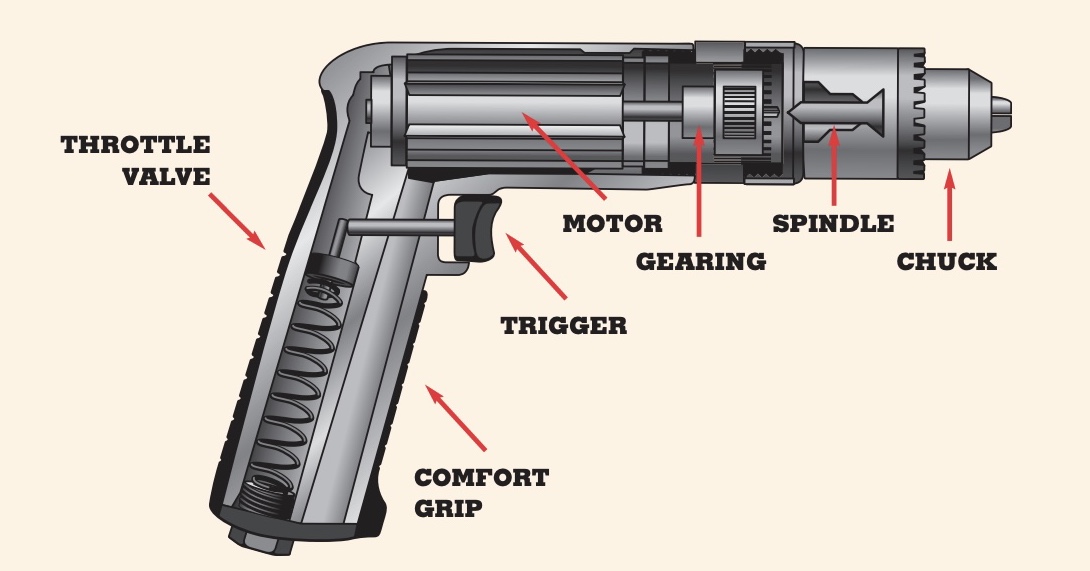
Types of Pneumatic Drills, Their Features, and Applications
Different pneumatic drill types are suited for specific tasks, expanding beyond conventional drilling.

Pistol Grip Pneumatic Drill's ergonomic design provides comfortable handling and exceptional control during drilling tasks that require precision and steady hands. The grip style enhances maneuverability so operators can achieve accurate results across various materials. Their versatility makes the drill a reliable option for tasks ranging from simple woodwork to more intricate metal drilling. A Keyless Chuck allows for rapid bit changes reducing downtime and enabling a seamless transition between drilling jobs involving frequent bit swaps or adjustments. However, in our experience we have found that keyless chucks are not as robust as a standard Jacob's style chuck, especially not in a production environment.
The elongated, inline design of Sioux inline drills set them apart as a must-have tool for precision drilling in confined spaces, including applications that demand accuracy and controlled movements. Their slim profile enhances maneuverability, allowing operators to navigate tight corners and restricted areas with ease. From intricate woodwork to delicate metal projects, the Inline Pneumatic Drill is an indispensable choice when access is limited, and precision is crucial.
Right Angle Drills are extremely popular in aerospace production environments allowing for exceptional accessibility.
D-Handle Pneumatic Drills address the demands of heavy-duty applications with an emphasis on control and stability thanks to the secure D-handle grip. Enhanced stability minimizes operator fatigue and the drill's robust design makes it ideal for construction, metal fabrication, and other industrial drilling work. We even have customers who use D Handle drills with reamers for reaming galvanizing out of hinges.
T-Handle drills find frequent application in industries such as heavy truck and trailer body manufacturing, where they excel in swiftly installing wood or metal flooring. These drills exhibit exceptional performance in decking tasks, thanks to their low RPM for elevated driving power and stall torque. With a T-Handle drill, the operator can stand upright while boring holes or affixing self-drilling and self-tapping screws. This ergonomic approach effectively minimizes strain on the operator's back and arms, enhancing both comfort and efficiency during operations.
Here are some popular models from the Sioux Tools Signature Series SDR10T. These tools can deliver a wide range of speeds from 400 to 4000 RPM and are available in 3/8" and 1/2" chucks. All Sioux T handle drills feature a 1 horsepower "drop in" motor for quick tune ups. Have a back up drop in motor on hand to avoid costly downtime.

Factors to Consider When Choosing the Right Pneumatic Drill for the Job
There are a few non-negotiable things when selecting a pneumatic drill for specific applications because each plays a role in ensuring the tool's effectiveness for specific tasks, as discussed below:
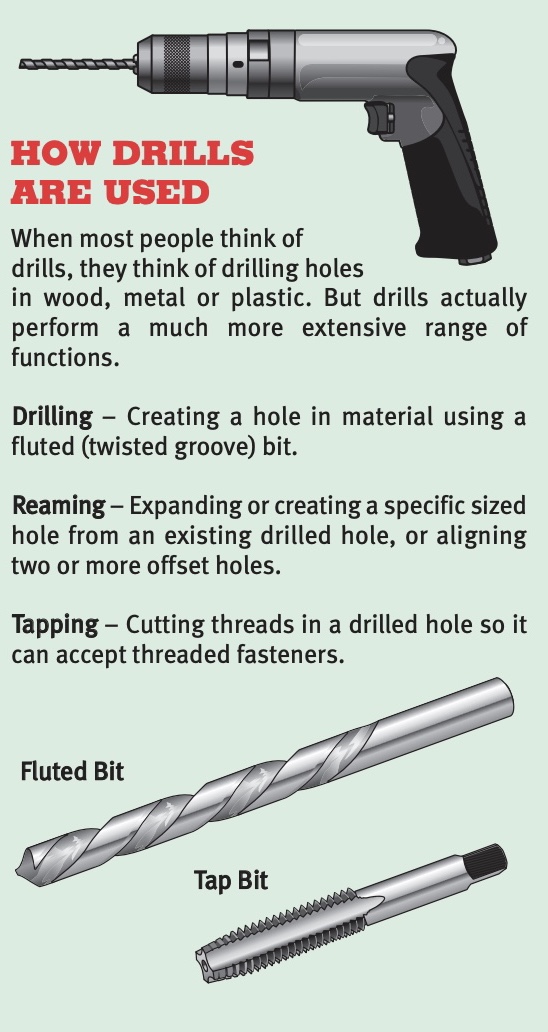
Match Drill Specifications and Job Applications:
- Handle/Grip Style: As mentioned above, different handle designs offer varying levels of control and comfort. The nature of the task and user preference helps determine the optimal handle style for precise and efficient operation.
- Chuck Capacity: Consider the range of drill bits that can be accommodated. The chuck should comfortably hold the required bit size without compromising stability during drilling.
Factor in the hole size, depth, and the required precision. Pneumatic drills cover a wide range of industrial needs:
- Production drilling – Continuous, heavy-duty usage, such as preparing holes on an airframe, drilling pilot holes for furniture assembly, or drilling holes for attachment points on fabricated steel or fiberglass.
- Tapping and Chasing Threads – Preparing a hole to receive a fastener (e.g., a bolt) by creating threads (tapping) and cleaning threads (chasing).
- Wire Brushing – Cleaning metals or removing rust using a special drill bit having a wire brush affixed at the tip (just make sure not to overspeed the brush)
- Light Deburring – Removing “burrs” or unwanted pieces of material. For continuous deburring tasks you should look into pneumatic grinders.
- Screwdriving – Drills are often used to install and remove screws. However, if you're doing consistent fastener work you should use a dedicated pneumatic screwdriver with some type of torque controlled clutch.
- Hole Sawing – Creating a hole by cutting out a circular section of material using a special drill bit.
Material Considerations:
Different materials require varying levels of force and speed to achieve precise results. A harder material might require a higher- torque drill, while a softer one may need a lighter touch. Choosing a drill with the correct speed range (RPM) for the job ensures optimal performance and extends tool life.
- Heavy- vs. Light-Duty Applications: A workload analysis will help determine if you need a heavy-duty drill that can handle higher torque and continuous operation for demanding tasks or a light-duty drill, better for intermittent tasks or jobs requiring precision.
- Motor Output Power: A higher horsepower (HP) motor might be suitable for heavy-duty applications. However, you still need to balance power with efficiency to prevent overkill and unnecessary strain on the tool.
- Free-Speed RPMs: The revolutions per minute directly affect drilling speed, so assess the range of RPM options available and select one that aligns with the intended application. Lower RPMs might be preferable for precision work to avoid damaging the material.
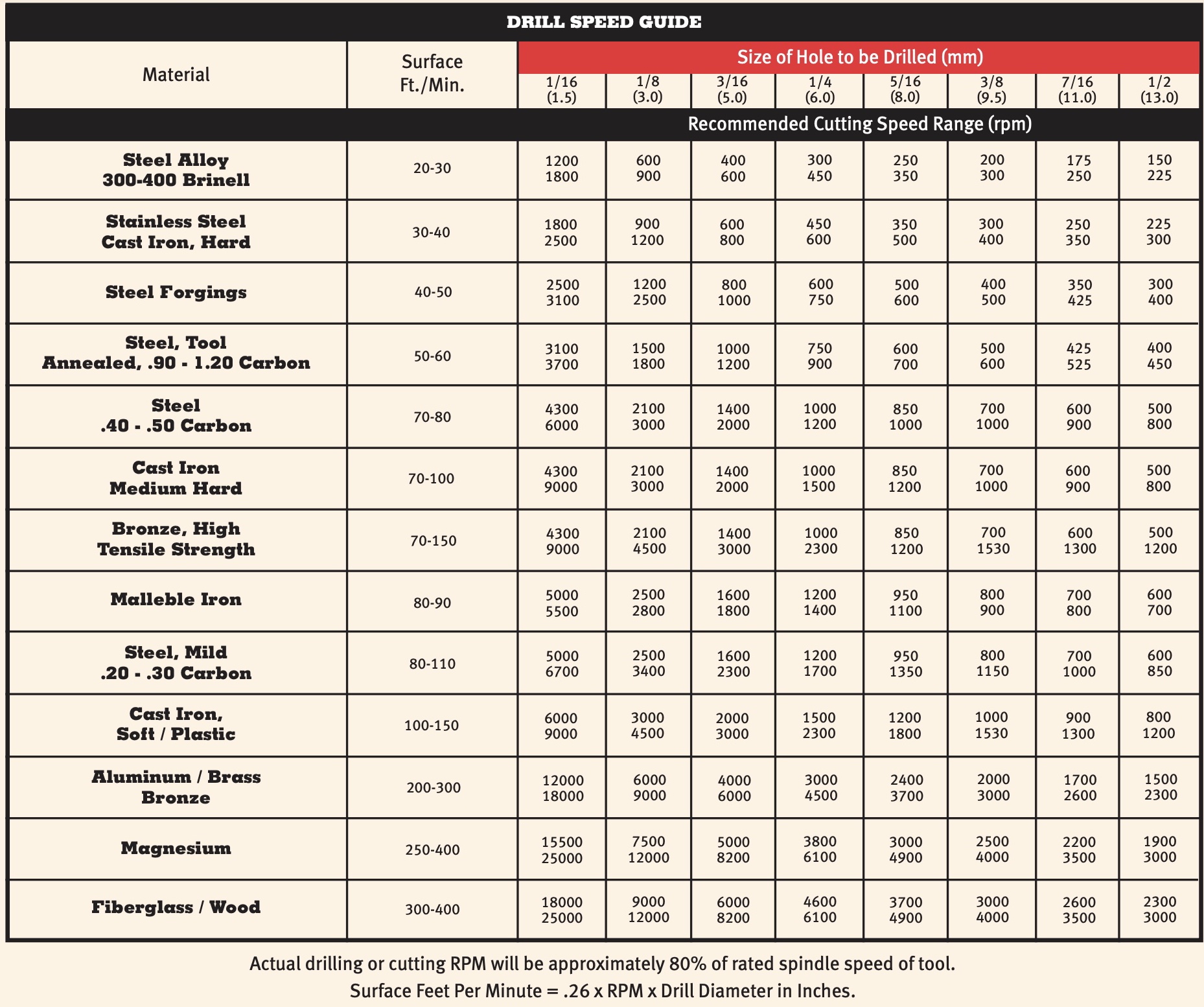
Serviceability and Drill Maintenance:

Choose a drill with accessible parts or components and easy maintenance guidelines. Consistent and proper care ensures an air drill retains its peak performance and continues to deliver reliable results over its operational life. Sioux Tools' on-site serviceability offers a cost-effective approach to maintenance that translates to reduced overall ownership expenses and upkeep costs for pneumatic drills.
Here's a general list of components that need regular inspection, cleaning and lubrication:
- Tipper valve and valve seat are easily accessible.
- Drop-in motor can be replaced without the need for alignment (non-reversing motors only).
- Rotor pinion is case hardened to resist wear.
- Grease zerk allows convenient lubrication without disassembly.
- Planetary reduction gearing can be serviced without removing the chuck.
- Ring gear is integrated with motor retainer. Machined-in design makes assembly and disassembly easy.
- Planetary gear pins are slip-fit designed for easy assembly and disassembly.
- Front endplate bearing is slip-fit de signed for easy access to the motor without disturbing rotor spacing.
More on the Sioux Drop-in motor:
A hallmark of Sioux's innovation lies in the "drop-in" air motor concept. This cutting-edge approach enables swift and seamless removal and replacement of the entire motor, demanding minimal tool disassembly and eschewing alignment prerequisites. Maintenance teams can now execute a full motor swap within a mere five minutes! Adding to the efficiency, the "Slip fit" style front end plate bearing allows effortless air motor servicing, without perturbing rotor spacing an added boon for time-conscious professionals.
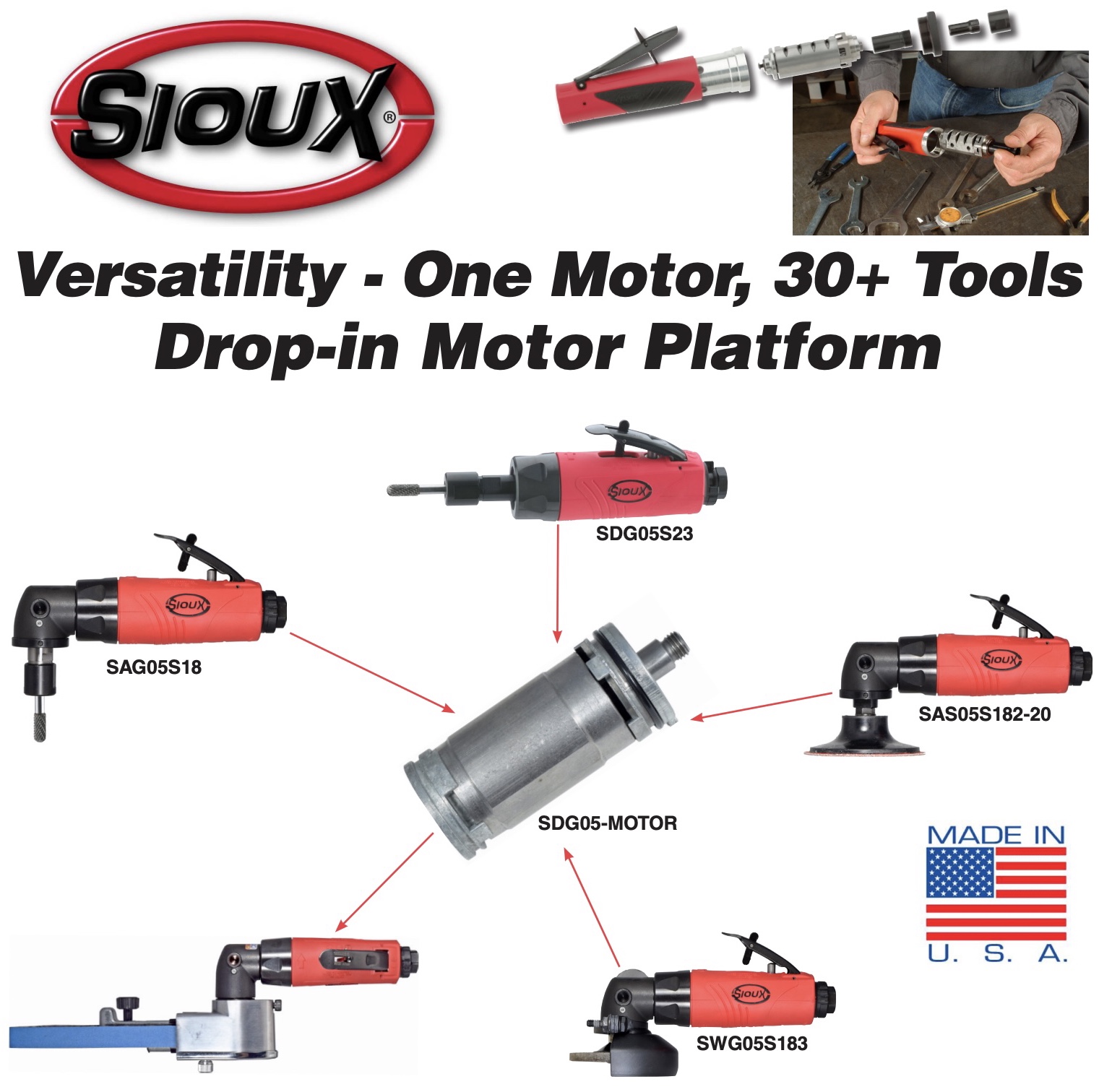
This breakthrough translates into tangible productivity enhancements, curtailed downtime, and a streamlined teardown and rebuild process. Sioux's air motors represent a quantum leap in operational ease, setting new benchmarks for productivity optimization.
Drill Handling Safety Tips
 Using a pneumatic drill demands strict adherence to safety guidelines due to possible accidents and injuries. The drill bit's high-speed rotation and pressurized air release can lead to flying debris, bit breakage, and sudden tool movements. Following proper safety measures, including eye protection, body positioning, disconnecting the drill during adjustments, and more, as discussed below, can mitigate these risks and ensure operator well-being
Using a pneumatic drill demands strict adherence to safety guidelines due to possible accidents and injuries. The drill bit's high-speed rotation and pressurized air release can lead to flying debris, bit breakage, and sudden tool movements. Following proper safety measures, including eye protection, body positioning, disconnecting the drill during adjustments, and more, as discussed below, can mitigate these risks and ensure operator well-being
Eye Protection: This goes without saying; always wear proper eye protection to shield against flying debris and potential bit breakage. You should also utilize hearing protection, such as earmuffs or earplugs, to guard against the loud noise generated by pneumatic drills, as it can lead to hearing damage over time.

Body Positioning: Maintaining a secure footing and proper body alignment when handling a power tool provides stability and balance, lowering the risk of losing control over the drill during operation. Should the drill encounter unexpected resistance or kickback, a well-balanced body position enables you to react quickly and minimize the chances of injury with every drilling operation. Always hold the drill with a firm and balanced grip, ensuring both hands are securely placed on the handles to manage the drill's vibrations and prevent accidental slips.
Inspect Accessories: Prioritizing safety in drill handling involves routinely inspecting drill bits and accessories for any signs of wear or damage before use. Replace worn or damaged components to help alleviate tool malfunctions for smooth and secure operations. Always clean and lubricate your pneumatic drill according to the manufacturer's instructions to keep it in optimal working condition and extend its lifespan.
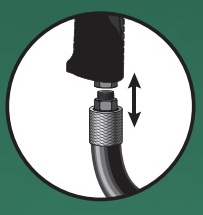
Workspace Clearing: Clear the work area of any obstacles, clutter, or unnecessary materials to avoid tripping hazards and to maintain a clean environment for safe drilling operations. When working indoors, ensure proper ventilation to decrease the inhalation of dust and debris generated by drilling, protecting your respiratory health. Familiarize yourself with the location of emergency shut-offs, first aid kits, and fire extinguishers in case of unforeseen accidents or incidents.
Disconnect Drills Safely: Before making adjustments or changing accessories, employ the proper procedure for disconnecting drills. As a precaution, turn off the air supply, release air pressure, and disconnect the drill from the air source to lessen the risk of accidental activation and ensure a secure environment.
Proper training in pneumatic drill usage is also highly advisable to enhance your understanding of its operation, safety protocols, and potential risks. By following these comprehensive safety measures, individuals can effectively reduce the likelihood of accidents and promote a secure working environment when using pneumatic drills.
Final Thoughts
Sioux pneumatic drills are essential for industrial manufacturing, assembly, and finishing applications. They stand as a testament to the recent advances in drilling technology. Sioux Tools has consistently delivered industrial equipment that meets the demands of precision-driven industries thanks to an extensive history of innovation and a commitment to quality. From their ergonomic designs to their reliable pneumatic mechanisms, these drills offer a combination of accuracy, power, and durability. Operators can trust in a century long legacy that continues to shape the precision drilling niche and create indispensable tools for achieving the highest levels of industrial efficiency.
![]() Looking for more information about Sioux Pneumatic Drills? Click here to view the Catalog
Looking for more information about Sioux Pneumatic Drills? Click here to view the Catalog
For more information please call (800) 608-5210 or email info@intlairtool.com


